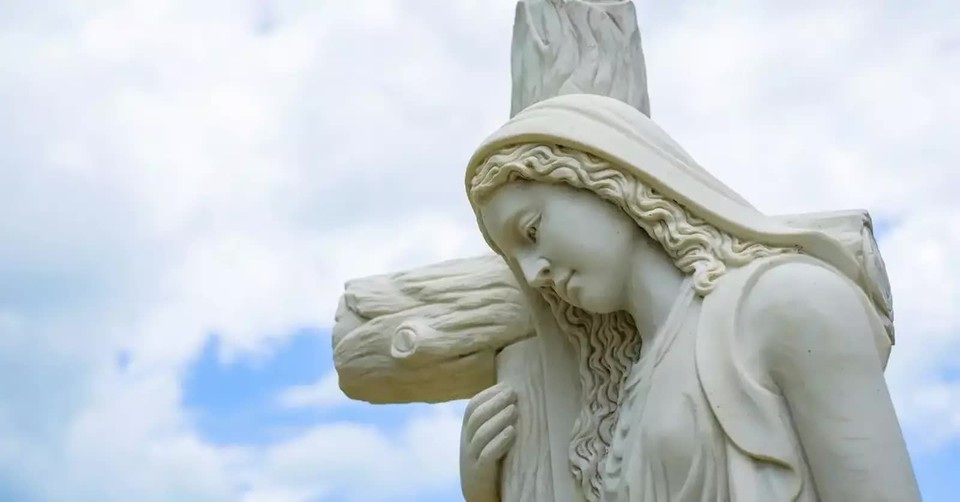Who Was Mary Magdalene in the Bible?

Mary Magdalene was a devoted follower of Jesus whose life was radically transformed when He healed her from seven demons. Her gratitude became a life of unwavering loyalty; she supported His ministry, stood by Him at the cross, and was the first to witness His resurrection. All four Gospels affirm her presence at these pivotal moments, highlighting her unique role as one of the few named female disciples and a key figure in the early church.
What Mary lived daily is the faith we all strive to achieve. What was so special about Mary Magdalene that Jesus chose her to walk out such an extravagant story? Who was Mary Magdalene really, and what happened to her after the resurrection of Christ?
The Story of Mary Magdalene in the Bible
Seven Demons Possessed Mary Magdalene
“Jesus traveled about from one town and village to another, proclaiming the good news of the kingdom of God. There Twelve were with him, and also some women who had been cured of evil spirits and diseases: Mary (called Magdalene) from whom seven demons had come out…” Luke 8:1-2
Mary was a Jewish woman from the fishing town of Magdala on the western shore of the Sea of Galilee. Her name is mentioned 12 times in the Gospels, more than most of the apostles. Mark and Luke recorded the healing of demons from Mary’s life in their Gospel accounts. For a picture of what it must have been like for Mary to suffer through this in the first century, imagine the shame of being linked to physical or psychological illness as a cause of the demon possession.
Maurice Casey, the author of Jesus of Nazareth, surmises that Mary must have suffered from severe emotional or psychological trauma to deem an exorcism necessary. She was battered and bruised, injured and in agony from the suffering demon possession entailed. Mary lost all control and dignity, along with everything she knew in her previous life. Beauty and wealth did not spare her from the evil that assailed and attacked her every hour of every day. “Seven is a mystic number suggesting ‘completeness,’ implying that when the evil spirits dominated Mary the suffering was extremely severe.” (All the Woman of the Bible)
One can only speculate what it was like at the moment Jesus looked upon Mary in her state of desperation. Only He could have seen who she really was regardless of her derailed state. Not only did He recognize her, but He commanded the demons to leave her. Though not many details are recorded about this event, her name is among the few mentioned in the recordings of Jesus’ healings. The friendship forged from the freedom she suffered through led to Mary’s entire life, henceforth serving as a reflection of her gratitude.
For more verses about Jesus’ miracles, click here.
Mary Poured Out Her Perfume on Jesus's Feet
She was one of many Marys who followed Jesus, being that it was the most common name for a Jewish female. Thus, when writing about her, it was necessary to clarify which Mary. Some historians claim that it was not Mary Magdalene who poured out perfume onto Jesus’ feet, but rather Mary of Bethany. Although the account is recorded in all the Gospel books, Mary Magdalene is never specified.
"A woman in that town who lived a sinful life learned that Jesus was eating at the Pharisee’s house, so she came there with an alabaster jar of perfume. As she stood behind him at his feet weeping, she began to wet his feet with her tears. Then she wiped them with her hair, kissed them and poured perfume on them." Luke 7:37 NIV
It’s also proposed that by confusing the two, an inaccurate version of a promiscuous Mary Magdalene circulated. It certainly makes sense for Mary to pour out perfume at Jesus’ feet. She’s often given credit for understanding the teachings of Jesus more than anyone else. So when he explains to a haughty Judas that “you will always have the poor, but you will not always have me,” it may seem plausible to give light to the possibility that it was the same Mary Magdalene who was delivered from seven demons.
Our Bible dictionary explains, "Mary Magdalene has become the type of a class of repentant sinners, but there is no authority for identifying her with the ‘sinner’ who anointed the feet of Jesus in Luke 7:36-50 either is there any authority for the supposition that Mary Magdalene is the same as the sister of Lazurus." No Bible reference suggests that she was involved in prostitution or had an immoral past.
Mary Magdalene's Relationship with Jesus
"After this, Jesus traveled about from one town and village to another, proclaiming the good news of the kingdom of God. The Twelve were with him, and also some women who had been cured of evil spirits and diseases: Mary (called Magdalene) from whom seven demons had come out; Joanna the wife of Chuza, the manager of Herod’s household; Susanna; and many others. These women were helping to support them out of their own means." Luke 8:1-3 NIV
Mary Magdalene’s presence here is more than a passing detail; it speaks of a profound personal history with Jesus. Having endured the torment of seven demons, Mary was delivered into freedom by Him. Such a radical redemption seems to have ignited in her an unshakable loyalty and deep gratitude. That she chose to follow Jesus and support His ministry financially may indicate she was a woman of considerable means. The name “Magdala,” according to All the Women of the Bible, means “tower” or “castle,” suggesting a heritage or status that may have placed her in a position of influence.
And yet, regardless of wealth or social standing, Mary had experienced the depths of suffering. How humbling it must have been for a woman of any station to be overtaken by spiritual torment. But how much more astounding, then, is her devotion to the One who healed her. She gave generously, not only out of her substance, but out of the abundance of her restored soul.
As Jesus continued throughout Galilee, teaching in synagogues and healing every kind of disease and affliction (Matthew 4:23, NIV), Mary was not a distant admirer. She was there, walking behind Him, listening, giving, serving. In a time and culture when women were seldom included in the religious or public sphere, Jesus welcomed them into the heart of His mission. As The NIV Cultural Backgrounds Study Bible notes, although women generally had fewer resources than men, some were indeed wealthy. Scholars even suggest that about one-tenth of all patrons in antiquity were women.
Mary Magdalene’s relationship with Jesus, then, was not merely that of a grateful follower; it was one of transformative devotion. Her life was reoriented by love and healing, and she became one of the few who remained with Jesus through His crucifixion, and the very first to witness His resurrection. From a past haunted by darkness to a future lit by faith, Mary Magdalene stands as a living testimony to what it means to be changed and cherished by Christ.
Mary Magdalene in the Easter Story
“Some women were watching from a distance. Among them were Mary Magdalene, Mary the mother of James the younger and of Joseph, and Salome.” Mark 15:40 NIV
The four Gospel accounts record the presence of women at the foot of the cross. Mark 15:40 records Mary Magdalene, Mary, mother of James, and Salome. Matthew 27:55-56 Mary Magdalene, Mary, mother of James and Joseph, and the mother of the sons of Zebedee. Luke mentions the group but does not identify them. John lists Mary, mother of Jesus, her sister Mary, wife of Cleopas, and Mary Magdalene. EP Sanders posits, “The reason why the women watched the crucifixion even after the many disciples had fled may have been because they were less likely to be arrested, because they were braver than the males, or because of some combination there of."
“Mary Magdalene and Mary the mother of Joseph saw where he was laid.” Mark 15:47 NIV
Mary remained until Jesus’ body was taken down from the cross and followed to witness Joseph of Arimathea’s burial of Jesus.
“Mary Magdalene and the other Mary were sitting there opposite the tomb.” Matthew 27:61 NIV
She watched Jesus’ burial and knew the exact location where he had been laid to rest. Mary knew the path so well that she could trace her steps back in the dark days later. The NIV Cultural Backgrounds Study Bible states, “Mary’s travel to the tomb in the dark, even though she is not from Jerusalem, requires serious commitment.”
“The women who had come with Jesus from Galilee followed Joseph and saw the tomb and how his body was laid in it.” Luke 23:55 NIV
What must it have been like for Mary to witness an empty grave? Kelly Minter puts it beautifully in her article “Follow the Women at the Tomb:”
“Mary sat with her tears long enough to peer into the tomb and see something the men hadn’t seen. Angels. They asked her why she was crying. She gave the most telling answer: ‘They have taken away my Lord.’" (John 20:13)
Mary Magdalene's Life after the Resurrection
“Now it was Mary Magdalene and Joanna and Mary the mother of James and the other women with them who told these things to the apostles.” Luke 24:10 NIV
Mary was the first to tell the complete gospel story. When the angels told her to “go” in Mark 16:7, she became the first to feel the call and pull of Christ on her life to tell of His resurrection. Women were not called to testify in that age, and their word didn’t lend credibility to any historically recorded event. Why would Christians place these women at the center of the Gospel account — in a society where women were not held in equal regard to men? Some early documents credit Simon Peter for seeing Jesus first and suggest it aggravated him that Mary was so close to Jesus.
Many of the disciples and Apostles lived lives of evangelism, many becoming martyrs for the early establishment of Christianity. What about Mary Magdalene? Her powerful witness of Jesus Christ was undoubtedly put in place to strengthen the faith of others. There are some who claim she married the apostle John, and others that she accompanied him to Ephesus. Still more say that she evangelized southeastern France and spent her last 30 years in an Alpine cavern. There are still more stories and legends, including one legend that tells a story of her and other disciples being stranded on a rudderless boat in the middle of the sea and miraculously coming ashore.
But legends aside, one thing is certain. This woman held a special place in the story of Christianity and was placed there by God.
Through her eyes, we learn a little more about who Jesus was. He found her in her darkest place and healed her miraculously. She was one of His friends and a faithful follower. Mary’s actions perhaps spoke the loudest, supporting Jesus’ ministry with all she had to give. To what she thought was the bitter end, she gave her life to follow Him and care for Him. The sweetest note of her story is not knowing that her Savior stood before her in that empty grave. She was so side-swept by her grief that she didn’t realize He was standing before her.
"At this, she turned around and saw Jesus standing there, but she did not realize that it was Jesus.
He asked her, 'Woman, why are you crying? Who is it you are looking for?'
Thinking he was the gardener, she said, 'Sir, if you have carried him away, tell me where you have put him, and I will get him.'
Jesus said to her, 'Mary.'
She turned toward him and cried out in Aramaic, 'Rabboni!' (which means 'Teacher').
Jesus said, 'Do not hold on to me, for I have not yet ascended to the Father. Go instead to my brothers and tell them, ‘I am ascending to my Father and your Father, to my God and your God.’' " John 20:14-17 NIV
For more verses about the resurrection of Jesus Christ, click here.
Photo credit: ©Thinkstock/Rauluminate
Originally published November 05, 2018.







